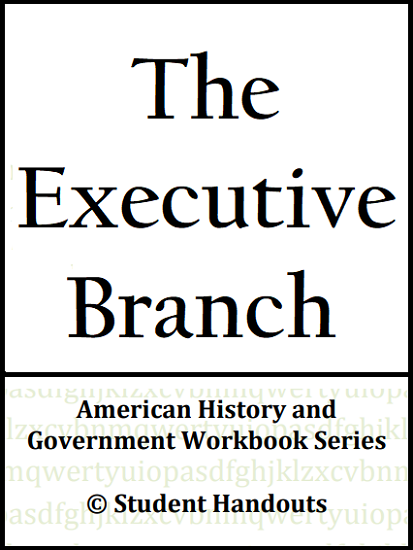| The Executive Branch Workbook |
|---|
| www.studenthandouts.com ↣ Social Studies ↣ Civics ↣ Executive Branch of the U.S. Government |
|
"The Executive Branch" focuses on this branch of the federal government. This workbook is designed for use by students at the junior and senior high school levels. The text explores the roles of the president and vice president, as well as of the Cabinet, executive agencies, and more.
This 26-page workbook includes over 60 questions and activities, ranging from basic recall to critical thinking. The easy-to-follow format encourages independent student learning. It can operate as a stand-alone unit or as a supplement to the larger study of American history and government. |
 |
    |
|
Click here to print. Answer key follows. The Executive Branch: 1. C - Power to change the Constitution through executive order. 2. Cabinet and independent federal agencies. 3. 4,000,000. The President: 4. Article II. 5. 15. 6. CIA and EPA. 7. Federal Reserve Board & Securities and Exchange Commission. 8. Answers will vary. 9. D - Veteran of the armed forces. 10. Answers will vary. 11. Electors (members of the Electoral College). 12. Barack Obama. 13. Grover Cleveland. 14. Franklin Delano Roosevelt. 15. White House. Vice President: 16. To be ready at a moment's notice to assume the presidency if the president is unable to perform his/her duties. 17. Made it so that the vice president and president are elected as a pair, rather than the presidential candidate with the second greatest number of votes becoming vice president. 18. A - True. 19. Joseph R. Biden. 20. United States Naval Observatory. Executive Office of the President: 21. Franklin D. Roosevelt. 22. White House Chief of Staff. 23. National Security Council. 24. Answers will vary. The Cabinet: 25. An advisory body made up of the heads of the 15 executive departments. 26. Attorney General. Department of Agriculture: 27. Develops and executes policy on farming, agriculture, and food. 28. By providing surplus foods to developing countries. Department of Commerce: 29. Improving living standards for all Americans by promoting economic development and technological innovation. 30. By assisting and enforcing international trade agreements. Department of Defense: 31. To provide the military forces needed to deter war and to protect the country's security. 32. B - Pentagon. 33. Answers will vary. Department of Education: 34. To promote student achievement and preparation for competition in a global economy by fostering educational excellence and ensuring equal access to educational opportunity. 35. Answers will vary. Department of Energy: 36. To advance the national, economic, and energy security of the United States. Department of Health and Human Services: 37. Medicare and Medicaid. Department of Homeland Security: 38. D - Wage war against enemy foreign governments. 39. Terrorist attacks of September 11, 2001. 40. U.S. Customs Service, U.S. Coast Guard, U.S. Secret Service, Transportation Security Administration, Federal Emergency Management Agency. 41. Answers will vary. Department of Housing and Urban Development: 42. National policies and programs that address America's housing needs, that improve and develop the nation's communities, and that enforce fair housing laws. 43. Community Development Block Grant Program. Department of the Interior: 44. To protect America's natural resources, offer recreation opportunities, conduct scientific research, conserve and protect fish and wildlife, and honor U.S. trust and responsibilities to American Indians, Alaskan Natives, and U.S. responsibilities to island communities. 45. 20% (one-fifth). 46. Bureau of Indian Affairs, the Minerals Management Service, and the U.S. Geological Survey. Department of Justice: 47. C - Oversee the imposition of martial law in foreign countries. 48. Drug Enforcement Agency (DEA), the Federal Bureau of Investigation (FBI), the U.S. Marshals, and the Federal Bureau of Prisons. 49. Attorney General. Department of Labor: 50. Federal programs for ensuring a strong American workforce. 51. Bureau of Labor Statistics. 52. Occupational Safety and Health Administration. Department of State: 53. B - False. 54. 180. 55. Secretary of State. Department of Transportation: 56. To ensure a fast, safe, efficient, accessible and convenient transportation system that meets vital national interests and enhances the quality of life of the American people. 57. Three of the following: Federal Highway Administration, Federal Aviation Administration, National Highway Traffic Safety Administration, Federal Transit Administration, Federal Railroad Administration, Maritime Administration. Department of the Treasury: 58. Promoting economic prosperity and ensuring the soundness and security of the U.S. and international financial systems. 59. By improving the safeguards of U.S. financial systems, implementing economic sanctions against foreign threats to the U.S., and identifying and targeting the financial support networks of national security threats. Department of Veterans Affairs: 60. Administering benefit programs for veterans, their families, and their survivors. 61. 25,000,000. 62. 25% (a quarter, or 70,000,000). Matching: 1. A - Cabinet. 2. H - President. 3. D - Franklin D. Roosevelt. 4. G - Pentagon. 5. F - Justice Department. 6. I - Vice president. 7. J - White House. 8. B - DOI. 9. E - Grover Cleveland. 10. C - Electors. |
| www.studenthandouts.com ↣ Social Studies ↣ Civics ↣ Executive Branch of the U.S. Government |








